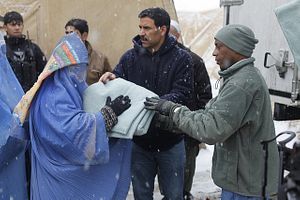During the Brussels conference earlier this month, international donors pledged more than 15 billion dollars in financial support to fund Afghanistan up to 2020. But the aid has prompted considerable debate about the way the money is spent and its potential social consequences.
In 2010, when news leaked to the media that then Afghan President Hamid Karzai was receiving “bags of cash” from the Iranian government, a reporter wrote, “it is enough to walk for half an hour along the worn-out and rugged streets of Kabul to see a number of lush new buildings rising in the midst of dirty and decayed clay huts.” Faheem Uddin makes the inference that “this means that there are some people who know how to make money out of the scarce resources this poor country possesses. There are basically only two: drug trafficking and foreign aid.” The same reporter wrote, “it looks as if Karzai and his clan fully realize that he is a temporary ruler in this war-torn country, and as such he and his associates use any opportunity to secure a comfortable life once they are gotten rid of – either by the West or by Afghans themselves.”
The story of foreign aid for Afghanistan is a sad one and several arguments have been put forward in a bid to explain why it has failed to truly deliver for Afghanistan.
One such argument takes the form of rhetoric emerging mostly from the government of Afghanistan, which accuses contractors and subcontractors of taking the money out of the country. These claims may have some validity, but they don’t provide the whole story. From the point view of donor countries, the dysfunctional nature of the Afghan state’s can be blamed. The government simply lacked the capability to use aid efficiently. But the story does not end here.
In fact, both donors and Afghan officials have gravely erred in their strategy for distributing developmental aid, specifically in their approach to supporting sustainable security. Foreign donors and the Afghanistan government has adopted a strategy of “buying security”: more conflict, more aid. That is why nearly 80 percent of foreign aid has been allocated to the five most conflict-ridden provinces. The result has been disastrous: more aid associated with more conflict. There is a substantial evidence to suggest that substantial parts of aid went to local warlords and even found its way into the hands of the Taliban. As a result, highly secure provinces like Bamyan and Dykundi have missed out on the largesse. This unequal distribution means that the two most secure provinces, the most peaceful regions since 2001, are also the poorest and most underdeveloped parts of Afghanistan. But it is not just foreign donors: The Afghan government also allocates a greater budget to those areas where insurgents are active, hoping to attract local support.
The second mistake is that more than 80 percent of aid has been spent on short-term projects that seek to improve the security situation. Long-term capacity building and initiatives to strengthen the domestic economy were largely excluded from the list of priorities. It is for this reason that after 14 years the Afghanistan economy is still not self-sustaining and the country remains one of the most aid-dependent in the world. After 2014, when foreign troops withdrew, the growth rate declined significantly. Poverty rose from 36 to 39 percent of the population.
Consequently, a triple injustice has been done, triggering new social unrest. First, the structural sidelining of peaceful regions where insurgent groups are not active. Second, the tendency of non-governmental organizations to naturally concentrate on conflict zones. Third, unkind climate conditions in certain mountainous areas like the central region of Hazarajat. These three conditions have combined to marginalize a huge segment of Afghan society, particularly the Hazaras.
Unfortunately, donor countries – notably the United States – have paid relatively little attention to the social consequences of their aid distribution policies in Afghanistan.
The dispute over the 500kw electricity transmission line – the TUTAP plan, which is backed by the Asian Development Bank and which aims to link the energy-rich Central Asian republics of Turkmenistan, Uzbekistan and Tajikistan with Afghanistan and Pakistan – is but one example of certain areas of the country being marginalized. There are also signs of some communities being shut out from state institutions.
The Enlightenment Movement protest, which turned bloody when suicide bombers got involved, demonstrates that the actions of the Afghan government are no longer going unseen by the public. The bloody attacks on July 23 cost 100 lives. The government should not exacerbate the situation, particularly at a time when insurgent groups are sabotaging its sovereignty and its popular support is at its lowest since 2001.
Fighting corruption must be a major precondition for continued foreign assistance. More equal distribution of aid ought to be another. A more even distribution of aid based on ethnicity and geographic factors will avoid potential conflicts, such as the one that is ongoing over the electricity project.
Reza Farzam is professor of economics in Kabul University and Rustam Ali Seerat is pursuing his M.phil in International Relations at South Asian University, New Delhi.

































